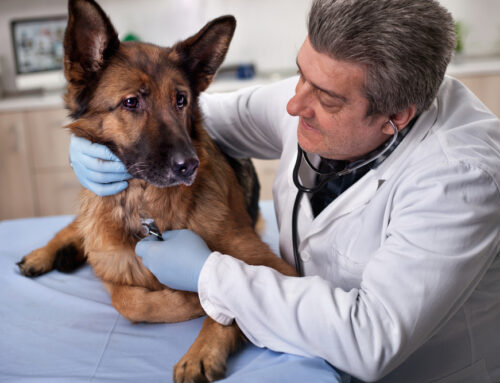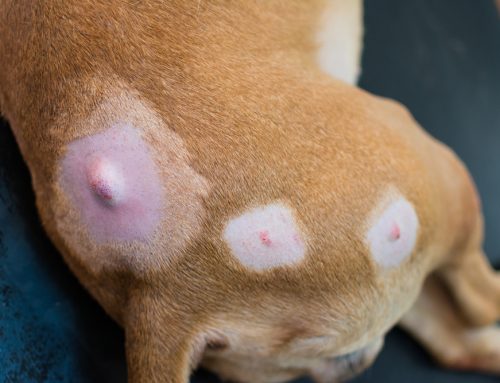Allergies—the thought alone can invoke dread in any sufferer. As we sniffle and sneeze our way through seasonal allergies, our pets itch and scratch. What exactly are our pets reacting to? Guam Pet Hospital takes a look at the types of pet allergies, and methods to manage them.
What are allergies in pets?
An allergy is a hypersensitive reaction of the immune system to a specific substance. The body perceives the allergen as a threat and produces histamine, triggering an inflammatory reaction.
Allergy signs in pets
Although the physiologic processes of allergies are identical in pets and people, their expression is different. While people suffer from respiratory signs, pets mainly experience their miseries through their skin. Here are a few common pet allergy signs.
- Excessive scratching, chewing, or biting
- Paw licking
- Rubbing of the face and muzzle
- Chronic ear or skin infections
- Poor hair coat, or hair loss
- Red or irritated skin
- Nasal discharge, sneezing, and, gastrointestinal signs
- Asthma in cats, although these signs are less common
Types of pet allergies
Most allergies fall into the following categories. One pet can have multiple allergy types.
- Flea allergy dermatitis — Flea allergy dermatitis (FAD) is one of the leading causes of skin disease in dogs, and is also common in cats. The immune system reacts to the flea’s saliva when the flea bites the pet. Only one flea bite is needed to trigger a dramatic reaction. FAD can occur throughout the year, appearing as excessive, generalized scratching, and redness, irritation, hair loss, and scaling at the tail base—a common site for fleas.
- Parasitic dermatitis — While not technically an allergy, pets plagued with ticks, mites, and biting lice suffer irritation and self-trauma to their skin, making parasitic dermatitis look similar to true allergies. A thorough veterinary examination of your pet’s skin and hair coat is necessary to determine whether your pet’s signs are allergic or parasitic in nature, and to direct their treatment accordingly.
- Environmental allergies — Skin disease caused by allergens in a pet’s environment, formally referred to as atopy, affects at least 10 percent of the canine population, second only to FAD in cats as the most common hypersensitivity disorder. Common triggers for environmental allergy are often inhaled or contact irritants, including:
-
- Dust mites
- Storage mites
- Grass and tree pollen
- Mold
- Blooming shrubs and foliage
If a pet is allergic to pollens and grasses, their allergy signs will intensify during the spring and summer, and regress or stop during the cooler months. Indoor pets with dust mite allergies will exhibit signs year-round.
- Pet food allergies — The prevalence of a true food allergy (i.e., an immune-mediated reaction to ingredients) is unknown, while food sensitivity (i.e., a digestive system reaction to ingredients) is much more common. A food allergy can occur at any time in a pet’s life, distinguishing the problem from environmental allergies, which often appear in early adulthood. The ingredients most pets are allergic to—beef, chicken, dairy, and lamb, and fish in cats—are also the ones most frequently included in commercial diets. Grain-free diets are a popular trend in pet foods, but the majority of adverse food reactions in pets are from protein sources rather than carbohydrates.

Pet allergy diagnosis and treatment
Talk to your veterinarian at the first sign of allergies in your pet. Delay can lead to intense and obsessive scratching and biting, and result in secondary skin and ear infections. Your veterinarian will perform a full exam, discuss your pet’s history and environment, and may perform skin testing to look for parasites or infection.
- Flea allergy dermatitis — The presence of fleas, flea dirt, or hair loss around the tail of your pet suggests FAD. Treatment entails consistent, year-round use of flea and tick preventives that should contain a repellent to stop the fleas from biting. Ticks, mites, and lice can also be treated with preventives. Not all products treat all pests, so ask your veterinarian for treatment recommendations based on your pet’s diagnosis.
- Environmental allergy — While skin testing for common allergies is available, the constant presence of dust, mold, and pollen makes these allergies impossible to eliminate. First, any secondary infections should be treated, and then management of allergy signs, including regular grooming, medicated shampoos, and medications that soothe the itch, can be instituted.
- Food allergy — A food elimination diet is used to diagnose and treat a food allergy. With veterinary guidance, your pet will receive a new diet they have never eaten before. This must be the only food—including treats—that your pet eats for eight to 12 weeks. After that, your pet can eat one ingredient at a time from their previous diet, and a reaction to an ingredient points to that food as the allergy trigger.
Skin disease is miserable for pets, and frustrating for owners. Taking a proactive approach at the first sign of allergies, and with guidance and treatment from Guam Pet Hospital, you and your pet can find relief. Contact us to schedule an appointment.








Leave A Comment